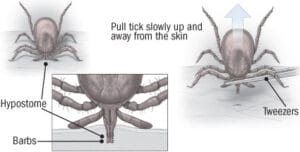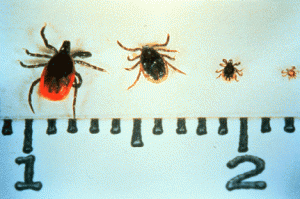April is Prevent Lyme Disease in Dogs Month. (Don’t you ever wonder who assigns all these special days and months?) Anyhow, Lyme disease is a major problem, especially if you live in the Northeast.
As it looks like spring is finally here and we’re spending more time outdoors, it’s time to think about ticks and Lyme disease prevention.
Lyme disease is one of the most common tick-transmitted (bacterial) diseases in the world. It’s typically transmitted to dogs via a tick bite. Apparently ticks must feed for at least 12 hours before transmitting the bacteria causing Lyme disease.
The Best Steps on How To Prevent Lyme Disease In Dogs
The best way to avoid infection is prevention. Make sure your dog is taking a monthly parasite preventatives (e.g. Advantix – see also our article on Advantix vs Frontline).
If you’re going out into the woods or elsewhere outside where you believe there are ticks, consider another layer of prevention via a tick collar (e.g. Preventic).
Not sure if your area has a risk of Lyme disease from ticks? Check out this great map from the ALDF.
After you’ve gone outside in a possible tick zone, make sure to check your dog for ticks. You can easily combine this with your dog’s grooming routine.
How Do You Remove a Tick?
According to VCA Hospitals, if you find a tick moving on your pet, the tick has not fed (whew!). Remove the tick promptly and place it in rubbing alcohol or crush it between two solid surfaces.
If you find a tick attached to your pet, remain calm.
Then get a pair of tweezers and grasp the tick with tweezers near the dog’s skin and firmly pull it straight out. Make sure you protect your fingers from exposure by using a tissue or a disposable glove.
If you crush the tick, do not get the tick’s contents, including blood, on your skin. The spirochete that causes Lyme disease can pass through a wound or cut in your skin.
Before you toss out the tick, consider keeping the dead tick (i.e. very well wrapped up and in a safe place) so you can take it to your vet (or your doctor if you were possibly also bitten).
Can ticks be tested for Lyme disease?
Yes, The tick can be tested for diseases. While it won’t necessarily rule out if you or your dog contracted Lyme disease (another tick could have bitten you), it doesn’t hurt to have more information.
The University of Massachusetts Laboratory of Medical Zoology (LMZ) has a two minute video that explains their tick testing service and a bit of background about their “Save the Ticks” campaign.
According to Erika de Papp, DVM, DACVIM in New England 50-75% of dogs tested may be positive for Lyme disease. Most dogs that test positive are not clinically ill, which makes it difficult to determine which dogs should be treated.
Apparently, only about 10% of dogs that have tested positive will ever develop clinical illness from infection with the Lyme organism, so many veterinarians argue that treatment is not necessary for seemingly healthy dogs.
There are two Lyme tests that assist vets in determining if the infection is active / recent. If your dog tests positive on a screening test, you should discuss additional testing with your veterinarian to determine if treatment is warranted.
The most common signs of illness from Lyme disease are lameness, fever, lethargy and enlarged lymph nodes. The majority of dogs respond very well to antibiotic treatment.
For more information about tick-bite protection for tick-borne disease prevention check out the TickEncounter Resource Center (TERC) at the University of Rhode Island. Remember to also discuss these important topics and issues with your veterinarian.





